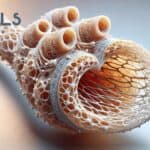Glioblastoma is one of the most common and deadliest forms of brain cancer in adults. It results from mutations in cells called astrocytes, which normally play an important role in maintaining the function of the brain. These mutations turn these supportive cells into cancerous cells that aggressively invade tissue while continuing to expand, causing significant damage to the brain and its function. The deeply invasive nature of glioblastoma tumors, it often recurs after the initial treatment regime that consists of tumor removal followed by either chemotherapy using temozolomide or radiotherapy.
As it currently stands, there is a clear lack of effective treatments to eradicate this type of cancer. Glioblastoma samples were taken from patients who also exhibit significant variability, which dictates how they will respond to potential treatments. The heterogeneous nature of cancer, including glioblastoma, makes it difficult to find effective treatments and the complex behavior and microenvironment associated with this type of the disease are hard to replicate in vitro. The standard paradigms for evaluating potential treatments for glioblastoma often require screening drugs against glioblastoma cells cultured on 2D tissue culture plates. These conditions do not accurately represent the complexity of the in vivo environment as they do not recapitulate the effect of the vasculature and the associated immune cells nor do they allow the cells to migrate in three dimensions as they would in the body. Another commonly used strategy is to transplant human glioblastoma derived tumor cells into animal models for screening potential treatments. These models have additional issues that include variability in tumor engraftment and the need to implant these cells into immunocompromised mice to ensure cell survival post-implantation.
As mentioned earlier, the role of the 3D microenvironment has a large impact on how glioblastoma cells behave and thus there exists a need to develop improved 3D models for studying the behavior of these cells. 3D bioprinting has the potential to generate such complex models as detailed in a recent commentary (1). For example, our group used the RX1 bioprinter from Aspect Biosystems to generate a novel 3D model of glioblastoma (2). Here we used our unique fibrin-based bioink containing U87 human glioblastoma cells to generate ring-shaped constructs based on the specifications present in our initial computer-aided design (CAD) file. The resulting constructs exhibited high levels of cell viability and the cells seeded inside formed tumor spheroids. Additional analysis showed that the cells in our bioprinted constructs expressed higher levels of the glioblastoma stem cell marker CD133 as well as doublecortin which is also upregulated in glioblastoma cells, that suggests these cells are more tumor-like in our 3D system in comparison with 2D culture. Additionally, our lab recently discovered a novel small molecule cocktail for reprogramming human glioblastoma cells in non-proliferating neurons when cultured on 2D surfaces and inhibiting the formation of cancer spheroids in suspension culture (3). However, the effects of this novel treatment were less profound when tested on our novel 3D bioprinted glioblastoma model. Another recent study also illustrated how complex models of glioblastoma can be produced using 3D bioprinting (4). They used a prototype of an extrusion bioprinting system developed by Renishaw to generate constructs from a bioink consisting of alginate modified with the peptide sequence RGD containing different types of glioblastoma cells along with immune cells into disc-shaped constructs. They then demonstrated that the 3D cancer models showed greater resistance to treatment with cisplatin and temozolomide when compared to 2D models – further demonstrating the potential of 3D bioprinting to generate more relevant, humanized models for drug screening. Another recent study published in Cell demonstrated how glioblastoma organoids – mini tissues formed from stem cells that reproduce certain biological functions – could be generated from patient-derived samples using defined conditions and these organoids exhibited the characteristics of the tumors from which they were derived (5). This technology could potentially be combined with 3D printing to generate patient-specific models for drug screening. Overall, as 3D bioprinting technology advances, including the ability to generate complex constructs using advanced bioactive inks that support cell survival, so will the development of such tissue models for drug screening applications.
References
About the Author:

Dr. Willerth holds a Canada Research Chair in Biomedical Engineering at the University of Victoria where she has dual appointments in the Department of Mechanical Engineering and the Division of Medical Sciences as a Full Professor. She runs an active research group that engineers tissues from stem cells and is currently starting a company to sell bioinks for engineering neural tissues. She serves as the Acting Director for the Centre for Biomedical Research at the University of Victoria and on the steering committee of the B.C. Regenerative Medicine Initiative. Her honors include being named the 2018 REACH award winner for Excellence in Undergraduate Research-inspired Teaching, a Woman of Innovation in 2017, one of the 2015 Young Innovators in Cellular and Biological Engineering and a “Star in Global Health” by Grand Challenges Canada in 2014. She spent Fall of 2016 on sabbatical at the Wisconsin Institute for Discovery supported by the International Collaboration on Repair Discoveries International Travel Award where she wrote her book “Engineering neural tissue using stem cells” published by Academic Press. She completed her postdoctoral work at the University of California-Berkeley after receiving her Ph.D. in Biomedical Engineering from Washington University. Her undergraduate degrees were in Biology and Chemical Engineering from the Massachusetts Institute of Technology.
Related Articles:
3D Bioprinting Bone – One Defect At A Time
3D Bioprinting: Chiasm of Art, Design, Science, Technology, Evolution
Cancer: What 3D Printing (Bioprinting) Can do For Oncological Care
Control your 3D Bioprinting Hydrogels
Manufacturing of Functional Tissues In Vitro Using Bioprinting and Bioreactors




 Jan 25, 2020
Jan 25, 2020 






Comments